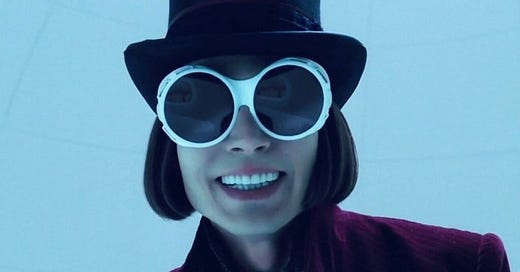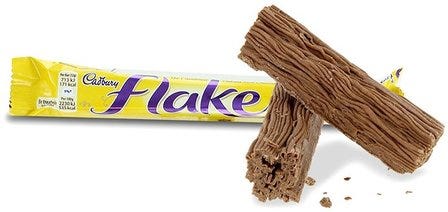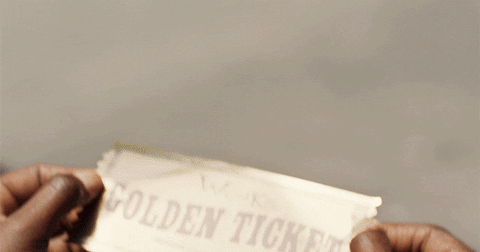Chocolate Dreams & Sweet Innovations
How a Happy Accident Led to Cadbury’s Flake, and How Willy Wonka Took It Even Further
Have you ever eaten something and thought: who came up with the idea of trying that out?
(For instance: eating possibly dangerous wild berries, or even looking at a cow and thinking, hmm milk?)
Or eating a delicious snack and wondering how that got made? For instance a Cadbury Flake?
It was one of my childhood obsession — even though it was nearly impossible to find in Portugal.
This delicate, melt-in-the-mouth chocolate wasn’t born from some grand master plan; it came from a happy accident. Someone at Cadbury noticed that chocolate, when heated just right, would fold and flake in the most delicious way. They took that quirky discovery and ran with it, turning it into one of the most beloved treats in the world.
And that, my friends, is intrapreneurship at its simplest: spotting a unique twist in the everyday and realizing it has the potential to become something big.
Today, though, we’re going a bit wilder than an intrapeneurship example from real life.
As you carefully unwrap this Sunday substack, treat it like those chocolate bars, with the aluminum foil and the paper.
And you find something… GOLDEN?
The Charlie and the Chocolate Factory wild story is our topic for today!
If Cadbury taught us how innovation can come from a twist of fate, Charlie and the Chocolate Factory shows us what happens when imagination is allowed to run free — maybe even a little too free (Luckily it’s Fiction. That factory’s work policies would drive any HR, Legal or Work Safety Director into straight madness!)
So, grab your golden ticket, and let’s dive into what this chocolatey world has to say about bold ideas, endless creativity, and (hopefully) avoiding a few Oompa-Loompa-worthy missteps along the way.
Charlie and the Chocolate Factory, famous book and movie, where the chocolate factory owner was wicked, chocolate rivers flow, gum tastes like a full-course meal, and there’s no shortage of pure, unfiltered chaos.
The Genius of Bold, Whimsical Ideas
When we think of innovation, we often think of groundbreaking ideas that seem just as fantastical as Willy Wonka’s candy inventions.
Think of products or companies that didn’t play by the rules – Apple revolutionizing tech aesthetics, Tesla pushing the boundaries of electric cars, SpaceX currently reinventing space travels, and Dyson reimagining household items like vacuums, hairdryers and fans. These companies didn’t just “tweak” existing products; they created a new experience (new phone experience, reusable spaceship, etc.), a new concept, daring to go and disrupt how things were being done by competitors.
Wonka’s chocolate factory is a playground for these kinds of bold ideas. He’s not satisfied with plain chocolate bars; he has a vision of candy that’s entirely different from anything else on the market. From a never-ending gobstopper to gum that contains an entire meal, he’s not just making treats – he’s changing the way people experience sweets. But there’s a catch to this kind of wild innovation, and it’s a big one. Which brings us to…
Innovation with a Side of Chaos (Where Wonka Goes a Step Too Far)
Wonka’s imagination is refreshing, but sometimes it goes so far that his inventions backfire. Remember the three-course dinner gum that turned Violet Beauregarde into a human blueberry?
Wonka’s approach is a classic case of “just because you can doesn’t mean you should.” In today’s world of innovation, the balance between creativity and practical application is key. Bold ideas are exciting, but you also need to make sure they solve real problems and bring value to people – without accidentally turning someone into a giant blueberry.
Walking the Line Between Genius and Madness
In the real world, even the most outrageous ideas need grounding. A lot of innovation teams, for example, try to instill Wonka-level excitement in their brainstorming sessions. They encourage wild ideas, letting creativity fly as high as it wants, just like the fizzy lifting drink. But they also know that once the brainstorming ends, you have to evaluate these ideas with a critical eye.
This is where "structured chaos" comes in. Just as Wonka had his factory rules (well, sort of), successful innovators create a framework for assessing ideas, testing them, and refining them before they hit the shelves. The fizzy lifting drink sounds amazing, but any company in the real world would probably hold a few focus groups and safety tests before releasing it to the public.
The Importance of a Grounded Team (aka. Don’t Go Full Wonka)
Wonka had Oompa-Loompas to run his factory, sure, but no one who could offer checks and balances on his ideas. If Wonka had a team of “realists” to balance out his wild ideas, he might have been able to create innovative products without all the unfortunate side effects. This is why any innovation team needs a mix of dreamers and doers – those who can envision wild new possibilities, and those who can bring them back to earth.
If you’re an innovator at heart, it’s great to have a “Wonka mindset.” But also think about having a “Charlie” on your team – someone who understands the value of restraint and thoughtfulness. Charlie isn’t there just for the spectacle; he’s there for the heart and the impact.
Let’s Put it All Together: Dream Big, but Don’t Skip the Sanity Check
Charlie and the Chocolate Factory is a reminder of what can happen when creativity has no guardrails.
Wild ideas when ideating? Good!
Wild ideas turn into a crazy, dangerous concept that actually drives no real value or doesn’t go with what stakeholders or users will want? Not good!
For innovation to succeed, you need that perfect mix of bold ideas and practical execution. So next time you’re dreaming up a wild idea, go ahead – let it be as fantastical as you want. But don’t forget to ask, Does it actually make people’s lives better? Does it solve a real problem? And is there a way to make sure nobody turns into a giant fruit?
Wrap-Up
If Wonka’s taught us anything, it’s that innovation without limits can be fun, even inspiring, but it’s the boundaries we set – the small reality checks we impose – that allow our best ideas to thrive. So go ahead and innovate like a Wonka, but keep a “Charlie” mindset close by to make sure your vision actually works in the real world.
So, as you step into the week ahead, keep an eye out for your own golden ticket to innovation. Who knows? That next big idea might just be waiting behind an “accidental” twist of fate or a moment of curiosity.
When you start work tomorrow, think like the Cadbury’s Factory workers: is there something we are doing and misusing or not taking advantage of? Instead of reinventing the wheel, can you make it better? Try to see where this gets you!
What has been your biggest, wildest idea? Have you executed it? Reply to this e-mail or comment on this, and let me know!








Great read! I love how "Wonka" is portrayed as the innovator and "Charlie" as the executor!
I keep on finding relatable stories from your newsletters here. Today, I am reminded of the story of invention of the paste-t notes. This story also connects your other post from last week - Do's and Don'ts for an intrapreneur.
1. In 1968, Spencer Silver at 3M accidentally created a reusable, pressure-sensitive adhesive that stuck lightly to surfaces but didn't bond tightly. Spencer wanted to create a strong glue, and was disappointed at first with this novel product.
Lesson for me - Failure are much more common as while building new stuff.
2. This light glue was used by Art Fry a few years later, to create a bookmark for his church hymnal.
Lesson - Sometimes, all we need is people with different perspectives around you. Same product, but a unique use case.
3. But 3M test marketed the product in 1977 as a "Press 'n Peel" in four cities, but the results were disappointing.
Lesson - Product worked great, but marketing is crucial to decide the ultimate make-or-break. An example of a great product but failed marketing - Tata Nano cars.
4. In 1978, 3M launched a massive marketing campaign called the Boise Blitz, which involved renaming the product to "Post-it Note" and giving out free samples. 3M started selling Post-its in 1980.
Lesson - Sometimes it takes years to get everything right: the product, the marketing, the funding and of course the team to do all of it.
5. In 2001, the patent for the glue expired, and many other companies began making similar sticky notes.
Final Lesson - We gotta keep innovating. If 3M had a way to "evergreen" their patent, they might have done it. Alas, they couldn't innovate sufficiently enough.
----
There's a LinkedIn post here I could probably write :)